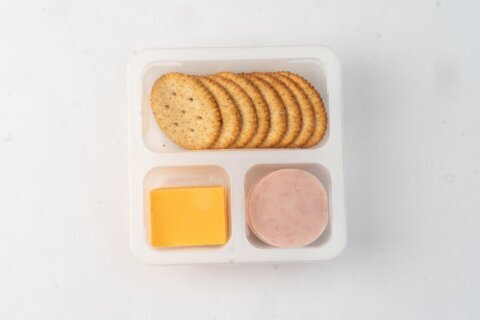Home cooking is increasingly viewed as an obesity prevention strategy and way to improve our family’s health. After all, we’re in control of the ingredients, portions and preparation methods when we make our own meals at home.
Yet a new study found that the longer women spent preparing meals at home, their odds of developing metabolic syndrome (a risk factor for diabetes and heart disease) went up. I certainly don’t want this to dampen anyone’s enthusiasm for cooking more at home. As it turns out, though, Michael Pollan’s oft-cited advice to “eat anything you want as long as you cook it yourself” may not necessarily hold true.
The researchers from Rush University Medical Center in Chicago admit we can’t draw too many conclusions from their findings, which were based on data from 2,755 women collected over the past 14 years. However, they do suggest we rethink broad public health messages that simply urge people to “just cook more.” They say our emphasis should be on cooking healthfully, not just frequently.
That certainly makes sense. I just hope people recognize the value of home cooking and gain the confidence to do it more often. Here are 10 ways you can be a healthier and happier cook:
Prep your kitchen. Set the mood with a spa-like setting for your kitchen, recommends Kait Fortunato, a District of Columbia-based registered dietitian. She suggests lighting candles, playing music and keeping counters tidy. “You’ll be much more likely to enjoy the prep and take your time with cooking if your kitchen is welcoming and clean,” she says. Fortunato also recommends keeping spices and herbs in jars on the counter where they’re easily accessible. “Not only can they add decor to your kitchen, but you will be more likely to use fresh ingredients if they’re not buried in your pantry.”
Get organized. If you’re not organized, you can’t find what you need to cook anything, says Susan Weiner, author of “The Complete Diabetes Organizer: Your Guide to a Less Stressful and More Manageable Diabetes Life.” She recommends organizing your foods by “use” rather than “fit,” so you can easily find what you need for meal preparation. That means instead of stuffing certain items in your cupboard or fridge just because you found a space where it fits, organize by use instead. Group similar items together and keep healthy snacks in plain view.
Plan ahead. Kelly Plowe, a Los Angeles-based registered dietitian, says the key is planning ahead. “Like most, my work week is pretty busy, so I spend an hour or so on Sundays acting as a prep cook,” she says. “I wash, cut, peel and chop all the fruits and vegetables I’ll need for snacks and meals for the week. I also batch cook my grains, like rice and quinoa. If I have the time, I portion out what I’ll need for snacks — like an ounce of nuts or a cup of berries. These little shortcuts add up to time saved during the week, and I eat healthier.”
Keep it simple. “With the growing popularity of cooking competition television shows and gourmet food magazines, cooking dinner can seem daunting, says Jessica Cox, a culinary nutritionist at eMeals. “But a delicious and healthy home-cooked meal doesn’t have to require sous vide or liquid nitrogen. Keep it simple with both your ingredients and the technique. Don’t let the pressure to Instagram a restaurant-quality, magazine cover-worthy meal keep you from making dinner at home. If you keep it simple, you can do it!”
Embrace shortcuts. To save time in the kitchen, Kim Larson, a national media spokesperson for the Academy of Nutrition and Dietetics, recommends buying bagged and shredded cabbage, carrots and pre-chopped romaine. “It’s easy to eat more veggies when you have them on hand and ready to go into a recipe, side dish or stir-fry. I also like adding frozen bags of vegetables (peas, corn, pearl onions) to soups and stews to save time and boost nutrition. I also keep a variety of canned beans on hand to throw into soups, stews, pastas and green salads. More fiber and more nutrition right off the shelves in the pantry — ready when you are.”
Get equipped. Invest in some new cookware to inspire you to cook more often. Leslie Bonci, a registered dietitian and sports nutrition expert in Pittsburgh, loves her cast iron skillet. It not only helps iron-enrich a meal, she says, but one can build great biceps at the same time. She frequently uses her sturdy skillet for stews, chili and spaghetti sauce. “What we typically cook in a cast iron skillet is a liquid-y type food to make us feel fuller for longer. You can use high hea t, which means you don’t really have to add fat to cook meats, and it’s a one-pot clean up. So it’s not only a time saver in prep, but it means less time in cleaning up afterward.”
Learn a new technique. Rebecca Subbiah, a registered dietitian and blogger at Chow at Chatter, loves to stir-fry, using a combination of vegetables and noodles. “It’s flavorful and fun, plus it’s a great way to clean out the fridge and decrease food waste.” Regina Ragone, food director at Family Circle, is fond of roasting her vegetables, especially parsnips and sweet potatoes. Simply toss in a little olive oil or nut oil and sprinkle with sea salt, then spread on a sheet pan for roasting at about 425 degrees Fahrenheit. Jill Weisenberger, author of “The Overworked Person’s Guide to Better Nutrition,” is partial to packets, made from parchment or aluminum foil. Start with some pre-cooked grains and then top that with fish, chicken or beef. Spread vegetables and seasonings around, and wrap up your packet and stick in the oven. “I usually make a packet for each family member, plus one for my lunch the following day. Or sometimes I make dinner for the entire family in one large packet on a baking sheet.”
Veggie up. Prepare some of your veggies at the beginning of the week and store in reusable containers in your fridge, recommends registered dietitian Kati Mora, founder of AroundthePlate.org. Keep them separate for easy sides, or mix together for an easy addition to soups, stews, omelets, rice and quinoa mixes. Registered dietitian Liz Weiss, co-founder of MealMakeoverMoms.com, is not a fan of sneaking vegetables onto kids’ plates, but she’s an advocate of weaving finely diced and shredded vegetables into favorite recipes. When making tacos for dinner, peel and shred a carrot and add it to the ground beef or turkey as you sauté, she suggests. Add sautéed chopped bell pepper to quesadillas, chili and pasta sauce.
Cook once, eat twice … or more. Make a large batch of a whole grain (such as quinoa, brown rice or whole-grain couscous), and add different foods to it throughout the week, such as vegetables, herbs and canned salmon or tuna, recommends Megan Ware, a registered dietitian and owner of Nutrition Awareness. “One day you could have a southwest-style salad with your grain as your base, then add red pepper, corn, grilled chicken and avocado with a squeeze of lime and a few tablespoons of salsa. The next day you could have a Mediterranean-style salad with your grain base, feta cheese, canned salmon and kalamata olives.” Registered dietitian Sharon Salomon likes to grill extra chicken breasts to stash in the freezer. “That way, I have cooked chicken I can use for making tortilla soup, chicken salad or chicken cacciatore.”
Focus on flavor. If you want to eat healthy, your food has to taste good, says Rachel Begun, a registered dietitian and culinary nutritionist. She stresses that the key is making it easy to flavor your foods. Work on preparing flavoring agents on the weekend so it takes less time to get healthy meals on the table during the week. “Make a pot of vegetable or chicken stock — it elevates the flavor of grain dishes, gets soup on the table quickly and is excellent for sautéing vegetables. Make a batch of salad dressing that can be used throughout the week — a lemony vinaigrette goes well with all greens and can even dress grains and bean dishes. Always have a pantry full of dried herbs and spices.”
More from U.S. News
Easiest Diets to Follow: in Pictures
Quinoa 101: What It Is and How to Cook It
10 Habits to Help You Be a Healthier, Happier Cook originally appeared on usnews.com







